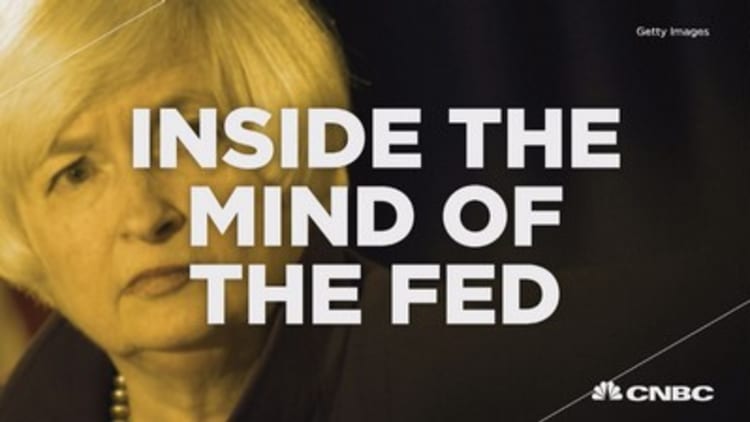
A lot has changed since the Federal Reserve decided in September once again to take a pass at raising interest rates and normalizing monetary policy. For hawks, not much of it has been particularly good.
When choosing not to move last month, the Federal Open Market Committee referred to some vague "international developments" it was monitoring to decide when it would enact its first rate hike since 2006.
For Wall Street, the message was clear: Fed officials worried that the slowdown in China would spread to other areas of the global economy, dampening prospects at home and making it the wrong time to lift off from the zero-bound range where it has been for seven years.
Since then, the news from China has gotten marginally better, with the government reporting that gross domestic product gained 6.9 percent in the most recent period.
The news from home, though, has improved little. Expectations for U.S. third-quarter GDP have tumbled in recent weeks, with the consensus now at just a 1.7 percent gain, according to FactSet, down from 3.9 percent in the inventory-inflated second quarter and well off hopes for 2.5 percent or better. CNBC's Rapid Update tracker has the estimate down to 1.4 percent.
A batch of economic data points Tuesday helped drive home the weakness: Consumer confidence declined and was below economist expectations, orders for long-lasting goods fell in line with consensus at 1.2 percent, and the Markit Purchasing Managers Index survey of manufacturing activity hit its lowest level since January, with the hiring component particularly worrisome.
Read More Junk bond market betting big against Fed rate hike
Indeed, the jobs market, considered perhaps the brightest spot in the economy, has tailed off considerably, with September adding just 142,000 positions, according to the latest government report that came out after the last Fed meeting.
Not to mention corporate profits, which currently are tracking for a 3.8 percent decline in the third quarter, according to S&P Capital IQ.
"Global weakness, a large inventory overhang, economic uncertainty — take your pick. The current environment leaves businesses hesitant to invest in everything from equipment to structures to additional employees," Lindsey Piegza, chief economist at Stifel Fixed Income, said in summing up the most recent indicators.
The conditions add up to a headache for the Fed during a year in which Chair Janet Yellen and her top lieutenants repeatedly have expressed a desire to begin the rate normalization process. The first hike was supposed to happen in March, which would have been five months after the Fed ended its quantitative easing program, a series of monthly bond purchases that exploded the central bank's balance sheet past $4.5 trillion.
Read More The US is closer to deflation than you think
Now, the target again appears to be March, but in 2016. Traders at the CME assign just a 1 in 20 chance that the FOMC will announce a hike on Wednesday. The outlook has dimmed so much that traders say there's a 16 percent probability the Fed will still hold steady next September.
Fed watchers should expect the FOMC to tone down its assessment of the economy in the statement it releases at the meeting's conclusion, said Joseph LaVorgna, chief U.S. economist at Deutsche Bank.
"The financial markets will treat the marking down of the Fed's near-term assessment of the economy as dovish, thereby further reducing the probability of a December 2015 rate hike, because the data will simply not be strong enough to convince the financial markets the Fed can actually begin tightening," LaVorgna said in a note.
"And if the Fed determines that it really wants to raise rates this year, the likely tightening in financial conditions that would accompany such a desire would give policymakers pause," he added. "Therefore, we do not expect a rate hike until the March 2016 meeting at the earliest."
Read More Chance of recession highest in two years: Survey
Sure, there's been a rebound of sort in the global equity markets, but even that only seems to exemplify how much investors have come to depend on monetary largess from the Fed and its global counterparts. The index had been in a sharp tumble around the time of the September meeting, falling more than 12 percent from its July peak until it cratered 12 days after the FOMC decision.
Since then, the market is up nearly 10 percent, buoyed in part by hopes of a lower-for-longer Fed.
Summing up the Faustian bargain between the two entities, Hans Mikkelsen, credit strategist at Bank of America Merrill Lynch, wrote, "Global weakness is OK for U.S. markets as long as the Fed refrains from hiking rates, and vice versa it would be OK from a markets perspective for the Fed to begin hiking rates if global weakness diminishes (but not OK if US data rebounds in isolation)."
Mikkelsen added that it's important the Fed acknowledge that the U.S. growth story is deteriorating.
"Hence risk assets have rallied for three weeks prompted by the turn to weaker U.S. data that began with the weak September jobs report, as the Fed's rate decision is understood to be completely data dependent," he said. "However, clearly for the market rally to be sustained it would be helpful if (the) FOMC statement tilted dovish by acknowledging this turn to weaker U.S. data."






